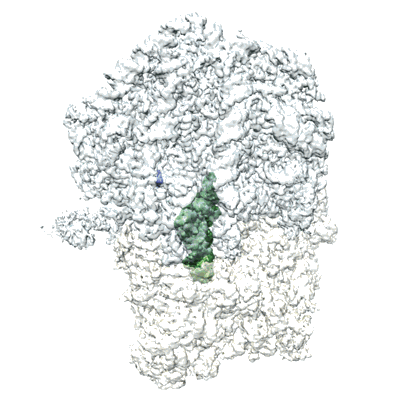EMD-23785
80S rabbit ribosome stalled with benzamide-CHX
EMD-23785
Single-particle3.2 Å
 Deposition: 06/04/2021
Deposition: 06/04/2021Map released: 01/09/2021
Last modified: 20/11/2024
Sample Organism:
Oryctolagus cuniculus,
synthetic construct
Sample: 80S rabbit ribosome stalled with benzamide-CHX
Fitted models: 7mdz (Avg. Q-score: 0.502)
Deposition Authors: Koga Y ,
Hoang EM
,
Hoang EM 
Sample: 80S rabbit ribosome stalled with benzamide-CHX
Fitted models: 7mdz (Avg. Q-score: 0.502)
Deposition Authors: Koga Y
 ,
Hoang EM
,
Hoang EM 
Discovery of C13-Aminobenzoyl Cycloheximide Derivatives that Potently Inhibit Translation Elongation.
Koga Y  ,
Hoang EM
,
Hoang EM  ,
Park Y
,
Park Y  ,
Keszei AFA
,
Keszei AFA  ,
Murray J
,
Murray J  ,
Shao S
,
Shao S  ,
Liau BB
,
Liau BB 
(2021) J Am Chem Soc , 143 , 13473 - 13477
 ,
Hoang EM
,
Hoang EM  ,
Park Y
,
Park Y  ,
Keszei AFA
,
Keszei AFA  ,
Murray J
,
Murray J  ,
Shao S
,
Shao S  ,
Liau BB
,
Liau BB 
(2021) J Am Chem Soc , 143 , 13473 - 13477
Abstract:
Employed for over half a century to study protein synthesis, cycloheximide (CHX, 1) is a small molecule natural product that reversibly inhibits translation elongation. More recently, CHX has been applied to ribosome profiling, a method for mapping ribosome positions on mRNA genome-wide. Despite CHX's extensive use, CHX treatment often results in incomplete translation inhibition due to its rapid reversibility, prompting the need for improved reagents. Here, we report the concise synthesis of C13-amide-functionalized CHX derivatives with increased potencies toward protein synthesis inhibition. Cryogenic electron microscopy (cryo-EM) revealed that C13-aminobenzoyl CHX (8) occupies the same site as CHX, competing with the 3' end of E-site tRNA. We demonstrate that 8 is superior to CHX for ribosome profiling experiments, enabling more effective capture of ribosome conformations through sustained stabilization of polysomes. Our studies identify powerful chemical reagents to study protein synthesis and reveal the molecular basis of their enhanced potency.
Employed for over half a century to study protein synthesis, cycloheximide (CHX, 1) is a small molecule natural product that reversibly inhibits translation elongation. More recently, CHX has been applied to ribosome profiling, a method for mapping ribosome positions on mRNA genome-wide. Despite CHX's extensive use, CHX treatment often results in incomplete translation inhibition due to its rapid reversibility, prompting the need for improved reagents. Here, we report the concise synthesis of C13-amide-functionalized CHX derivatives with increased potencies toward protein synthesis inhibition. Cryogenic electron microscopy (cryo-EM) revealed that C13-aminobenzoyl CHX (8) occupies the same site as CHX, competing with the 3' end of E-site tRNA. We demonstrate that 8 is superior to CHX for ribosome profiling experiments, enabling more effective capture of ribosome conformations through sustained stabilization of polysomes. Our studies identify powerful chemical reagents to study protein synthesis and reveal the molecular basis of their enhanced potency.
